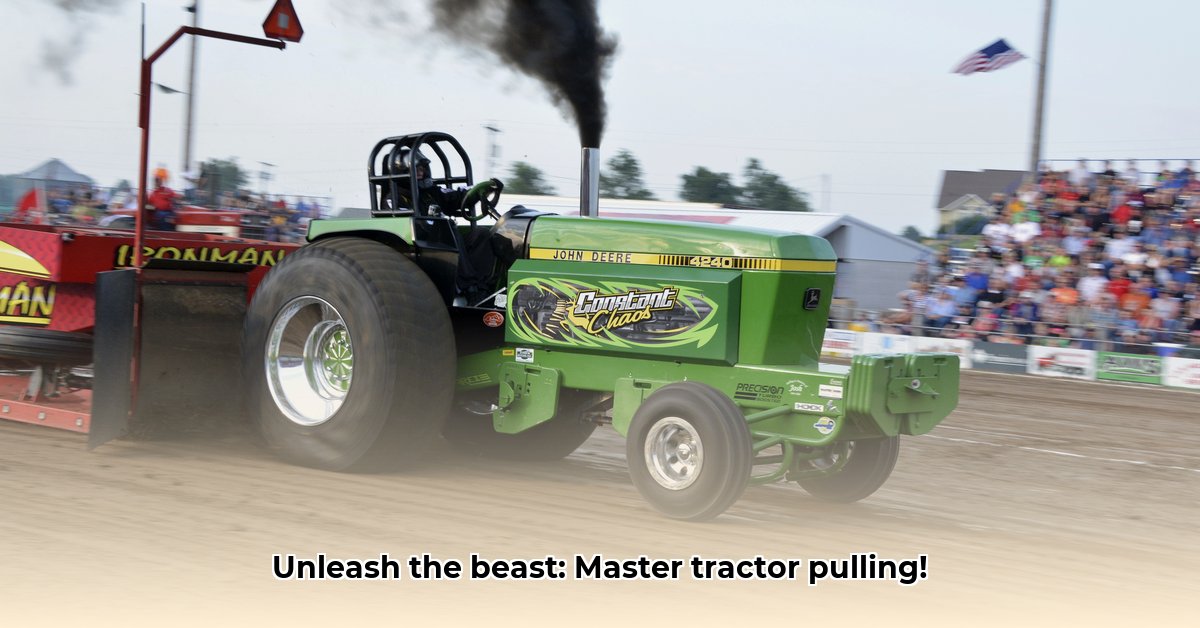
Tractor Pull Classes: A Comprehensive Guide
Ever witnessed the awe-inspiring spectacle of giant tractors battling it out, straining against incredible weights? This is the thrilling world of competitive tractor pulling! We'll dissect the various classes, illuminating what makes them so captivating. Consider it akin to boxing's weight classes—each presents unique rules and competitors, ensuring fair and exciting contests. What determines the success of a tractor pull? Is it simply raw horsepower, or is there more to it than meets the eye? For a list of famous pulling tractors, check out this resource.
Understanding Tractor Pull Classes: The Rules of the Game
What distinguishes one tractor pull class from another? Three key elements define the playing field: the tractor's weight, engine modifications, and sometimes, even the tractor's type. These rules create a level playing field. A heavily modified super-tractor wouldn't be a fair match against a standard farm tractor, would it? The regulations ensure similar machines compete, resulting in nail-biting finishes. How many tractor pull classes are there, and how do their regulations differ?
The Diverse World of Tractor Pull Classes: Stock to Super Modified
Many tractor pull classes exist, with rules varying across organizations. Here's a glimpse into some common types:
Stock Classes: Honoring Tradition: These tractors closely resemble their farm counterparts, with minimal modifications. Think of this as the baseline, showcasing the raw power of a standard tractor. It's an excellent entry point for both spectators and competitors. What advantages do stock tractors offer over modified ones?
Modified Classes: Enhanced Performance: Here's where things get exciting! Tractors boast beefed-up engines, custom chassis, and various upgrades. These machines are built solely for competition, representing the racers of the tractor world. What modifications are typically made to tractor pulls in this class?
Super Stock and Super Modified: The Elite Tier: These classes showcase the pinnacle of tractor pulling technology. Tractors are extensively modified, featuring extreme horsepower and cutting-edge engineering. They represent the peak of the sport, pushing the boundaries of what's possible. What technological advancements distinguish super stock and super modified tractors?
Decoding the Rules: Weight, Horsepower, and Beyond
Each class has detailed rules encompassing engine modifications and maximum weight. Understanding these rules is crucial for competitors, judges, and spectators alike, ensuring fair play and emphasizing skill and machine capabilities. What specific rules govern weight and horsepower in each tractor pull class?
The Dynamic Duo: Weight and Horsepower
Weight and horsepower are paramount. Generally, a heavier tractor pulls more weight, but requires sufficient horsepower for movement. Striking the right balance separates winners from the rest. It's a delicate balance: excessive weight slows progress, while insufficient horsepower renders heavy loads impossible. How do competitors balance weight and horsepower for optimal performance?
The Future of Tractor Pulling: Innovation and Sustainability
Several trends are shaping the sport's evolution:
Technological Advancements: New engine technology, stronger materials, and advanced drive systems constantly emerge, promising even more powerful and sophisticated tractors. What new technologies are expected to shape the future of tractor pulling?
Sustainability's Rise: Growing environmental concerns are likely to drive research into alternative fuels and eco-friendly designs, promoting a more sustainable sport. How might sustainability impact the design and operation of future tractor pull competitors?
Enhanced Fan Engagement: Organizers are enhancing the spectator experience with improved live streaming, fan interaction, and interactive elements, fostering growth and excitement. What initiatives are being undertaken to increase fan engagement in tractor pulling competitions?
Key Differences in Tractor Pull Classes: A Summary
The following table summarizes key differences (note that specifics vary by organization):
| Class Type | Typical Weight Range | Engine Modifications | Competition Level |
|---|---|---|---|
| Stock | Varies greatly | Minimal | Beginner to Intermediate |
| Modified | Varies; generally heavier | Significant | Intermediate to Advanced |
| Super Stock | Usually very heavy | Extensive | Advanced |
| Super Modified | Typically heaviest | Extreme, highly customized | Elite |
How to Maximize Horsepower in Tractor Pulling Competitions
Key Takeaways:
- Data analysis is crucial for optimal performance in modern tractor pulling.
- Engine tuning is paramount for maximizing horsepower and pull distance.
- Advanced technologies, like data acquisition systems, are vital for competitive success.
- Fuel type understanding is essential for engine performance.
- Ongoing R&D pushes the limits of tractor pulling technology.
Unleashing the Beast: Your Tractor's Power Potential
Think of a tractor pull as a high-stakes horsepower duel; the goal is maximum pull distance. Success relies on meticulous planning and advanced technology. Understanding your tractor's capabilities—engine power output and structural limitations—is crucial for maximizing its potential. How can understanding your tractor's unique characteristics improve your chances of winning?
Precision Engine Tuning: Optimizing Power Delivery
Engine tuning optimizes the entire power delivery system, involving adjustments to fuel injection, ignition timing, and air intake. Fuel type significantly impacts tuning strategy (diesel vs. methanol). Modern systems, such as those by Dewesoft, track engine parameters in real-time, providing crucial data for adjustments. How does real-time data analysis contribute to engine tuning for tractor pulls?
Data-Driven Decisions: The Power of Measurement
Data is key. Forget gut feeling – embrace precision measurement. Sensors monitor engine speed, boost pressure, transmission temperatures, and drawbar force. This data guides immediate adjustments and long-term development, refining strategies and unlocking more horsepower. Why is data analysis so important in maximizing a tractor's performance in a pulling competition?
Holistic Optimization: Beyond the Engine
Maximizing horsepower extends beyond the engine. Weight distribution, traction, and tire selection are crucial. Optimizing weight transfer and selecting appropriate tire compounds and pressures maximize grip and durability. How can optimizing aspects beyond the engine contribute to higher horsepower in tractor pulling?
The Future of Tractor Pulling: Innovation on the Horizon
The future holds more sophisticated data acquisition systems, powerful engines, and the exploration of alternative fuels. Advancements in materials science will lead to lighter, stronger tractors. The sport’s evolution reflects relentless pursuit of performance. What future technological innovations might further enhance tractor pull capabilities?